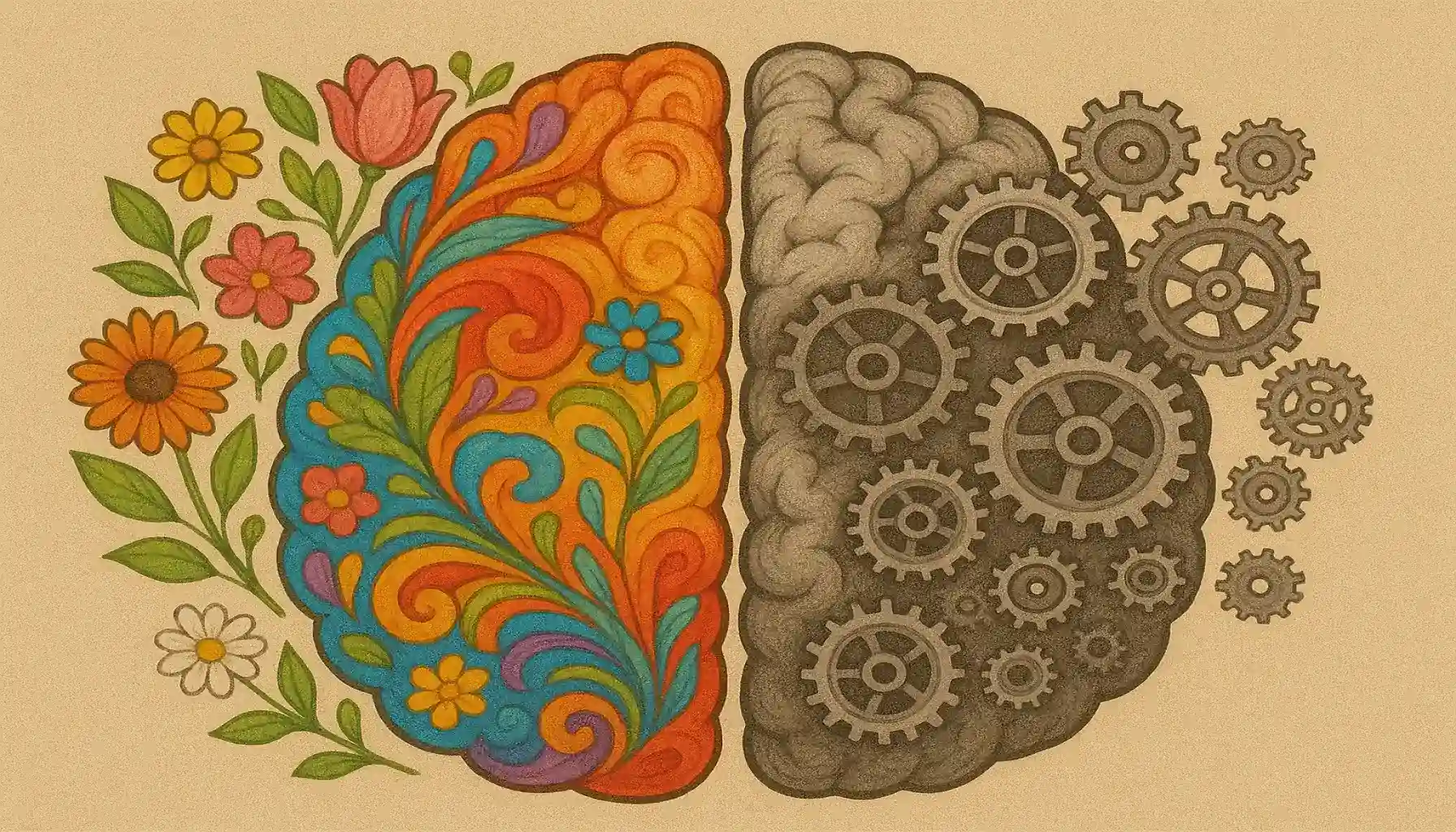Contents:
Are you "left-brained" or "right-brained”? You can read about it in a lot of pop psychology articles. This topic has been going on for so many years. Are you creative and emotional? Must be right-brained. Analytical and methodical? Clearly left-brained. But how accurate is this dichotomy? People memorize only the fact that somehow they have different parts of the brain responding to completely different things. Which is not true. By the way, if you’re interested in how the brain works and want to maximize your intellectual capacity, check out memory games from Mind Elevate.
As it turns out, brain lateralization is a well-documented neurological phenomenon. But oversimplification of brain left and right traits is not really what is going on in your head. We’ll talk about the latest discoveries about science behind hemispheric specialization and debunk common myths. Yes, the only thing is correct in those statements - the brain is divided into left and right hemispheres. But they work together far more often than they work in isolation.
Needless to say, the research on the brain keeps going on. And in the next 10 years or so we may discover that none of it is true. Neuroscience is pretty young science, and the tools, such as MRI or Doppler sonography keep renewing their models so we can better see how exactly the brain works.

Language and Speech
Language functions are typically lateralized to the left hemisphere in about 96% of right-handed people and 60–70% of left-handed. Things like grammar, vocabulary (lexicon), and syntax are stored there. In particular:
Broca's area (left frontal lobe) governs speech production
Wernicke's area (left temporal lobe) manages comprehension
The left side of the brain constructs and understands sentences, but the right and left brain work together to process emotional tone. The right hemisphere helps us to get the emotional side of conversation like sarcasm or humor. But still it cannot independently support full language structure. Left and right hemispheres of the brain collaborate more than they compete, read further to know why.
Emotional Prosody
The emotional content in speech like tone, rhythm, or sarcasm is processed in the right hemisphere. This explains why someone with right hemisphere damage may speak fluently but sounds robotic.
Sensory and Motor Processing
Contralateral Control
Most functions are processed on the opposite side of the brain. For example:
The left hemisphere controls the right side of the body
The right hemisphere controls the left side
Vision
Visual fields also cross over:
Left visual field → Right visual cortex
Right visual field → Left visual cortex
Hearing
Auditory signals are processed in both hemispheres but with a right-ear advantage for speech. It’s because it routes to the left brain, which dominates language.
Touch and Pain
Touch and pain signals decussate (cross over) in the spinal cord. This explains why damage to one hemisphere can result in numbness or pain on the opposite side of the body.

Sensory Input and Hemisphere Processing
Sense | Processed In | Notes |
Vision | Contralateral visual cortex | Partial decussation at optic chiasm |
Hearing | Both hemispheres (slightly left) | Right-ear words favor left-brain (language bias) |
Touch | Contralateral somatosensory cortex | Sensory crossover in spinal cord and brainstem |
Pain/Temp | Contralateral spinothalamic path | Crosses over earlier than touch |
Plasticity: When Brains Adapt
Brain plasticity is the ability of one hemisphere to compensate if the other is damaged. The left and right hemisphere of the brain are still pretty flexible after injury. For example, if a stroke disables Broca’s area in the left hemisphere, parts of the right brain may take over limited language production over time. Full recovery is rare, but the ability to do this shows the difference between right and left brain is not as rigid as once believed.
Hemisphere Damage and Its Effects
Left Hemisphere Damage
Language difficulties (Broca’s or Wernicke’s aphasia)
Trouble forming grammatically correct sentences
Difficulty with naming or structured speech
Sequential and logical memory disruption
Impaired visual labeling and symbol processing
Reduced verbal strategy use in memory tasks
Depression (especially when language deficits are present)
Frustration or withdrawal due to communication difficulties
Reduced motivation or persistence in tasks requiring verbal engagement
Right Hemisphere Damage
Trouble interpreting tone, sarcasm, or emotional cues
Problems with spatial reasoning and visual tasks
Disorganized, overly literal speech
Difficulty recalling visual scenes or mental Imagery
Behavioral and cognitive changes
Impaired facial recognition and emotional understanding
Lack of insight (anosognosia): patients may be unaware of their impairments
Impulsivity or disinhibition: especially if the damage affects the frontal regions
Difficulty with artistic or creative tasks due to disrupted memory visual integration
Of course, injuries are tragic, but people with right and left hemispheres of the brain injuries show us how each half specializes. Still, we know that both sides of the brain are required for the best function.

Real Experiments: Split-Brain Patients
Research on split-brain patients (people who had the corpus callosum severed, usually to treat epilepsy) showed how the right and left brain function independently.
So, the experiment: words presented to the left visual field (processed by the right hemisphere) could not be verbalized. The patient could still draw or select the object with the left hand. This showed the right brain and left brain can process different types of information when communication is cut off.
Take depression for example. This disease has shown that hyperactivity in the right hemisphere and hypoactivity in the left may correlate with increased pessimism and reduced logical processing.
Broca's and Wernicke's Aphasia: Case Studies
Broca’s aphasia is caused by damage to the left frontal lobe, often from stroke or injury. Speech becomes halting, effortful, and grammatically broken, but comprehension usually remains strong. This is how we know that this side of the brain’s key role in constructing language.
Wernicke’s aphasia results from damage to the left temporal lobe. Speech remains fluent and fast, but it lacks meaning. Sentences may include made-up words (neologisms), and patients are often unaware their speech is confusing. So the different language aspects are separated across the left and right brain areas.
Sex Differences
The left and right side of brain myth got popular in the 20th century through education and pop culture. While some studies show minor structural or activation differences between men and women, both use it for complex reasoning, emotional processing, and motor coordination. Right and left hemisphere of the brain imaging research has revealed subtle anatomical distinctions like a slightly larger corpus callosum in women on average, which some scientists propose may enhance communication between sides. Men sometimes show more lateralized activation during certain tasks like language processing or spatial navigation.
However, leading neuroscientists stress that these differences are small and don’t reflect fixed abilities or dominant traits. Most cognitive tasks whether logical, verbal, or emotional require bilateral brain activity.

The Truth About Brain Sides
Yes, the brain is divided into left and right hemispheres, each with some specialized functions. But most tasks, especially complex ones like conversation, problem-solving, or empathy, have both sides working together.
So, if you’ve ever taken any online test or heard someone say they’re “left-brained,” take it with a grain of salt. Ask them what exact region they mean, what exactly is prominent. Is it Broca's or Wernicke's area? Brain lateralization is real. But defining yourself by one side? That’s fiction.





